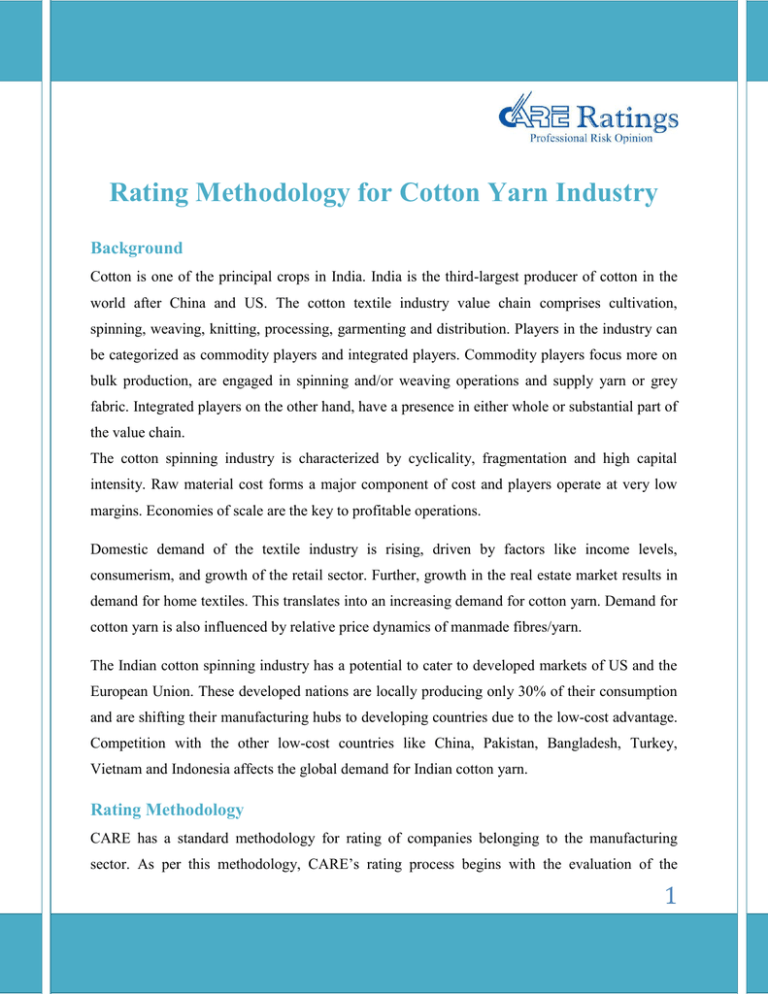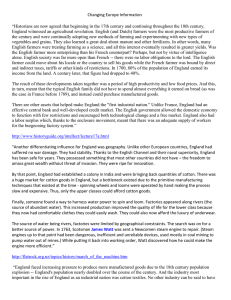Rating Methodology for Cotton Yarn Industry Background
advertisement

Rating Methodology for Cotton Yarn Industry Background Cotton is one of the principal crops in India. India is the third-largest producer of cotton in the world after China and US. The cotton textile industry value chain comprises cultivation, spinning, weaving, knitting, processing, garmenting and distribution. Players in the industry can be categorized as commodity players and integrated players. Commodity players focus more on bulk production, are engaged in spinning and/or weaving operations and supply yarn or grey fabric. Integrated players on the other hand, have a presence in either whole or substantial part of the value chain. The cotton spinning industry is characterized by cyclicality, fragmentation and high capital intensity. Raw material cost forms a major component of cost and players operate at very low margins. Economies of scale are the key to profitable operations. Domestic demand of the textile industry is rising, driven by factors like income levels, consumerism, and growth of the retail sector. Further, growth in the real estate market results in demand for home textiles. This translates into an increasing demand for cotton yarn. Demand for cotton yarn is also influenced by relative price dynamics of manmade fibres/yarn. The Indian cotton spinning industry has a potential to cater to developed markets of US and the European Union. These developed nations are locally producing only 30% of their consumption and are shifting their manufacturing hubs to developing countries due to the low-cost advantage. Competition with the other low-cost countries like China, Pakistan, Bangladesh, Turkey, Vietnam and Indonesia affects the global demand for Indian cotton yarn. Rating Methodology CARE has a standard methodology for rating of companies belonging to the manufacturing sector. As per this methodology, CARE’s rating process begins with the evaluation of the 1 economy/industry in which the company operates, followed by the assessment of the businessrisk factors specific to the company. This is followed by an assessment of the financial and project-related risk factors as well as the quality of the management. This methodology is followed while analyzing all the industries that come under the purview of the manufacturing sector. However, considering the size and diversity of the sector, CARE has developed methodologies specific to various industries within the sector. These methodologies attempt to point out factors, over and above those mentioned in the broad methodology, which will be assessed while carrying out rating exercises of companies belonging to the particular industry. The following are such additional factors, along with their analytical implications, considered by CARE while arriving at the rating of the players that operate in the cotton yarn industry. CARE emphasizes on both quantitative as well as qualitative factors while rating cotton yarn units. Quantitative analysis involves analyzing various cost parameters, inventory management, capacity utilisation, export sales, operating efficiency, etc, while qualitative analysis comprises analyzing factors like labour productivity, ability to undertake expansion/modernization, product mix and marketing strategy. CARE has identified following factors for the analysis of cotton yarn units: Cost management Raw material cost forms about 50-55% of sales, in a cotton spinning company. Cotton, being an agricultural commodity, its availability and price are dependent on the vagaries of nature. India produces most varieties of cotton. However, certain extra-long staple varieties are not produced in India and players using imported varieties of cotton are affected by international price trends in the cotton market. Power cost also forms a fair component of cost (about 10% of sales) and CARE analyses the power expenditure with reference to the efficiency of power consumption and quality of supply. Players using captive generation have an assured uninterrupted supply of power. CARE believes that efficient cotton procurement strategies like contract farming, proficiency in estimating the future trends in the cotton market, proximity to the cotton cultivation areas and optimal quantity of cotton procurement would help players in minimizing costs. Also players using alternative sources of power with a cost/quality advantage are viewed favourably. 2 Inventory management Cotton is a seasonal crop and is harvested from October to February every year. Inventory management thus plays an important role as companies procuring optimum quantities of crop and stocking raw material requirement for a considerable time can ensure availability of good quality raw materials at reasonable prices. Companies using efficient inventory management policies are viewed positively by CARE. Economies of scale As the industry is characterized by low margins, profitability depends on volume of sales and companies having high capacities can register satisfactory growth. High capacities can also help players in bagging huge orders. Further, companies having the capacity to manufacture on multiple lines can take the advantage of simultaneous production of different counts. CARE views companies operating on optimum capacities and multiple lines positively. Labour relations Labour cost constitutes about 6% of sales. Given the labour-intensive nature of the industry, companies having cordial labour relations are better placed in terms of labour productivity and smooth operations. CARE favourably views companies having cordial labour relations. Expansions / Modernisation Opening up of global markets in the post-quota regime, requires companies to undertake expansions and modernisations at the appropriate time so as to gain advantage of the growing markets and the demand-supply gap. Ability of spinning units to replace obsolete machines with modern state-of-the-art machines will enable companies to cater to the export markets and offer better quality products. Further, players foraying into downstream expansions can benefit from integrated operation. CARE critically assesses the project implementation risk in these ventures and positively views companies undertaking timely expansion/modernisation. 3 Product diversification Players having a diversified product portfolio tend to have more stable revenues. Players having finer count yarn in their product mix, cater to the elite market segment where demand is relatively price inelastic and margins are high. Companies having capacity to produce double yarn have better product flexibility. Further, companies producing blended yarn rather than only cotton yarn, can efficiently tackle the cyclicality in the cotton yarn demand. Also, companies focusing on value-added products can further improve their profitability. CARE views companies having presence in multiple product categories to be better equipped to withstand cyclicality in demand. Geographical diversification A player catering to both domestic as well as export markets can diversify the risk of sluggishness in a particular market. Export-oriented companies catering to various countries have lower country-specific risk. However, a large composition of exports calls for foreign exchange management policies as fluctuations in the foreign exchange market can adversely affect such players. CARE believes that companies having adequate product and geographical diversification are insulated against market risk and country-specific risk to a large extent. Conclusion The rating outcome is ultimately an assessment of the fundamentals and the probabilities of change in the fundamentals. CARE analyses each of the above factors and their linkages to arrive at the overall assessment of credit quality, by taking into account the industry’s cyclicality. While the methodology encompasses comprehensive technical, financial, commercial, economic and management analysis, credit rating is an overall assessment of all aspects of the issuer. 4 HEAD OFFICE - MUMBAI CREDIT ANALYSIS & RESEARCH LTD 4th Floor, Godrej Coliseum, Somaiya Hospital Road, Off Eastern Express Highway, Sion (East), Mumbai - 400 022. Tel: +91-022- 6754 3456 email:care@careratings.com Website:www.careratings.com Regional Offices Branch Offices Unit No. O-509/C, Spencer Plaza, 5th Floor, No. 769, Anna Salai, Chennai 600 002 Tel: (044) 2849 7812/2849 0811 401, Ashoka Scintilla 3-6-520, Himayat Nagar Hyderabad - 500 029 Tel.: (040) – 40102030/31, 91600 04563 3rd floor, B-47, Inner Circle, Near Plaza Cinema, Connaught Place, New Delhi - 110 001. Tel: +91- 011- 2331 8701/ 2371 6199 Cell: 98117 45677 Unit No. 8, I floor, Commander's Place No. 6, Raja Ram Mohan Roy Road, Richmond Circle, Bangalore - 560 025. Tel.: (080) - 2211 7140/41, 9886024430 3rd Floor, Prasad Chambers (Shagun Mall Building), 10A, Shakespeare Sarani, Kolkata - 700 071 Tel: (033)- 2283 1800/ 1803/ 2280 8472 32 TITANIUM Prahaladnagar Corporate Road, Satellite, Ahmedabad - 380 015. Tel.: (079) 4026 5656 5 Disclaimer CARE’s ratings are opinions on credit quality and are not recommendations to sanction, renew, disburse or recall the concerned bank facilities or to buy, sell or hold any security. CARE has based its ratings on information obtained from sources believed by it to be accurate and reliable. CARE does not, however, guarantee the accuracy, adequacy or completeness of any information and is not responsible for any errors or omissions or for the results obtained from the use of such information. Most entities whose bank facilities/instruments are rated by CARE have paid a credit rating fee, based on the amount and type of bank facilities/instruments. 6



